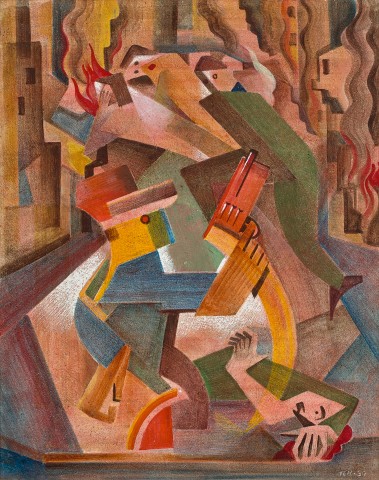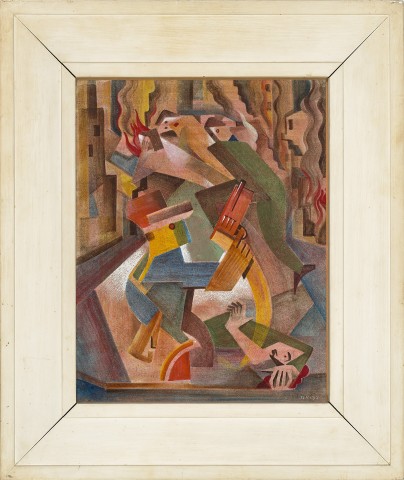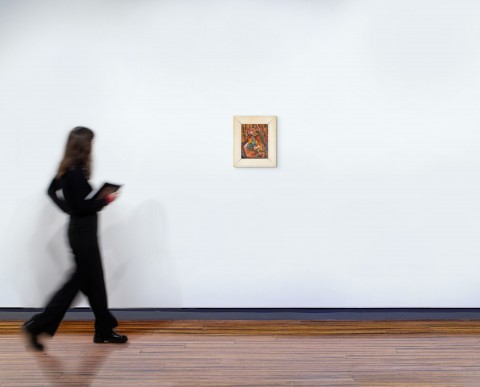LITTLE MAN WITH A BIG GUN (MUSSOLINI), 1939
FRANK HINDER
tempera on gesso on hardboard
28.0 x 22.5 cm
signed with initials and dated lower right: FCH-39
Private collection, Sydney, acquired directly from the artist, 20 December 1967
Frank and Margel Hinder: 1930 – 1980, Art Gallery of New South Wales, Sydney, 12 June – 13 July 1980, cat. 107 (label attached verso)
Frank and Margel Hinder, a selected survey, Bathurst Regional Art Gallery, Bathurst, 26 May – 3 July 1983; travelling to Lewers Bequest and Penrith Regional Art Gallery, 7 – 27 July, 1983, cat. 13 (label attached verso)
Brave New World: Australia 1930s, National Gallery of Victoria, Melbourne, 14 July – 15 October 2017
Free, R., Hinder, F., & Hinder, M., Frank and Margel Hinder, 1930-1980, Trustees of the Art Gallery of New South Wales, Sydney, 1980, pp. 13, 21
Free, R., Henshaw, J., and Hinder, F., The Art of Frank Hinder, Phillip Mathews Book Publishers, Willoughby, New South Wales, 2011, p. 99 (illus.)
Crombie, I., & Taylor, E., Brave New World: Australia 1930s, National Gallery of Victoria, Melbourne, 2017, pp. 151 (illus.), 182
Frank Hinder’s Little man with a big gun (Mussolini), 1939, is a highly significant painting, one of only two known works by Australian artists that comment directly on the rise of European Fascism in the lead up to World War Two. The other is Peter Purves-Smith’s The Nazis, Nuremberg, 1938 (Queensland Art Gallery | Gallery of Modern Art) which was his direct response to the antisemitic horrors he witnessed in Europe. It is important to note that these two works were painted some years before the renowned Anti-Fascist Exhibition of 1942, organised by the Contemporary Art Society, and featuring the work of artists such as Noel Counihan, Sidney Nolan and Albert Tucker. By that stage, war had been declared and the justifiable alarm at the actions of Hitler and Mussolini had finally galvanised artists into action. Ironically, Hinder’s premonitionary painting was not included.
Due to their mannerisms, histrionic theatrics and distinctive appearance, Hitler and Mussolini were easy to caricature to the point of cartoonish buffoonery. Mussolini in particular employed the Italian notion of braggadocio (boastful, arrogant behaviour), with jutting jaw, hands on hips, and bald head tilted back with machismo satisfaction. A pugnacious man, he had founded his National Fascist party (Italian Partito Nazionale Fascista) in 1921 – the first in the world, utilising violent thuggery against his political opponents. Indeed, Hitler was influenced in his own actions by Mussolini, not the other way round, but by the time war was declared, the power-balance had reversed. It is plausible that Hinder had this in mind by portraying the Italian dictator as a puppet, in turn echoing Alfred Jarry’s Père Ubu, the proto-Dada performance from 1896 about a greedy, foolish king which used marionettes for many of its protagonists. Hinder had used a similar motif earlier that year in his drawing of artist-colleague Eleanor Lange, pictured holding puppets of two Sydney art critics, Will Ashton and Sydney Ure-Smith.1 Even so, whilst Mussolini may be attached to strings, the victims of his actions are not, as they flee from his gun through a flaming city, whilst another lies bleeding at his feet. It is a bold, yet perfectly composed composition, which ‘just came without being planned, and for that reason was particularly respected by the artist.’2
Hinder’s sophisticated technique is fully apparent in Little man with a big gun (Mussolini), with the curves and shapes informed by his in-depth understanding of ‘dynamic symmetry’, a reinterpretation of design concepts based on Egyptian hieroglyphics and Greek pottery.3 Whilst he also found inspiration in Futurism and its English cousin, Vorticism, Hinder did not celebrate the violence of war as they did. What he did admire was their structural form, stating later that ‘I still believe art is design, discipline and control – but most important, design.’4 Technically, his use of the ancient medium of egg tempera (pigment bound by egg yolk) gives the surface of the painting a smooth, translucent finish which perfectly enhances his use of rich colouration. Significant works by Hinder from this period are now mostly found in institutional galleries, and include Commuters – two paintings, 1938 (National Gallery of Australia); Dog gymkhana, 1939, and Eleanor Lange, 1939 (both Art Gallery of New South Wales); and Expansion, 1938 (Queensland Art Gallery | Gallery of Modern Art).
1. Hinder subsequently established his own marionette theatre in the late 1940s.
2. Free, R. and Henshaw, J., with Hinder, F., The art of Frank Hinder, Phillip Mathews, Willoughby, New South Wales, 2011, p. 98
3. See Hambidge, J., Dynamic symmetry: the Greek Vase, Yale University, Connecticut, United States of America, 1920
4. Frank Hinder, cited in McGrath, J., ‘Design is still the key’, The Australian, 13 December 1976, p. 8
ANDREW GAYNOR


